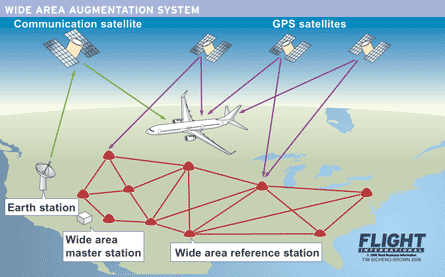The US Wide Area Augmentation System (WAAS) is the world's first satellite-based augmentation system (SBAS) to provide horizontal and vertical navigation for aircraft precision approaches.
Created by the US Federal Aviation Administration, WAAS has been operational since 2003. However, Europe's SBAS, the European Geostationary Navigation Overlay Service (EGNOS), is close behind, achieving initial operational capability in July 2005 and is scheduled to become fully operational in March 2007, a three-year slip from its original target date.
SBAS provides error correction to GNSS signals to deliver the greater accuracy and reliability required by aviation. The system achieves this by monitoring the navigation signals from the satellites at reference stations located across a large area such as the continental USA.
This data tells master stations about the satellites' orbit, drift in the accuracy of their on-board atomic clocks, and signal delays caused by the ionosphere. Correction signals are broadcast through geostationary satellites.
Both WAAS and EGNOS use the Navstar global positioning system (GPS) and their corrections improve the accuracy of the service from 10m-plus (33ft) to just 1m or 2m.

EGNOS is being developed by the European Space Agency (ESA) under a tripartite agreement between the European Commission, the European Organisation for the Safety of Air Navigation and ESA. EGNOS uses three geostationary satellites, Inmarsat's Indian Ocean Region and Atlantic Ocean Region-East satellites and ESA's Artemis spacecraft, to transmit that error correction data to its 34 ranging and integrity monitoring stations (RIMS) located from Lisbon to Turkey. As well as RIMS, its ground network uses four interconnected master control centres. ESA claims the EGNOS service's coverage area could eventually cover all European states and be extended to other regions, such as South America, Africa, and parts of Asia and Australia.
In 2003, WAAS had two master stations, its own geostationary satellites and 25 reference stations. The FAA has been adding more of its RIMS, four in Alaska and five in Mexico. Under an agreement Mexico and Canada will be able to use WAAS.
Today the FAA is rolling out WAAS localiser performance with vertical guidance approach information across US airports at a rate of 300 runways a year. It is certificated down to 200ft, equivalent to a Category 1 instrument landing system.
The FAA is also researching the use of WAAS and GBAS for providing Cat 2 and 3 approaches. This would also be possible in Europe with a single GPS reference station facility at an airport. The US version of this is called Local Area Augmentation System.
Other countries developing GPS augmentation systems are India, with its GPS and Geo Augmented Navigation Japan with its Multi-Functional Satellite Augmentation System and Russia, which is developing its own global navigation satellite system's SBAS.
SBAS and GBAS will replace VHF omni-directional range and distance measuring equipment.
Source: Flight International























